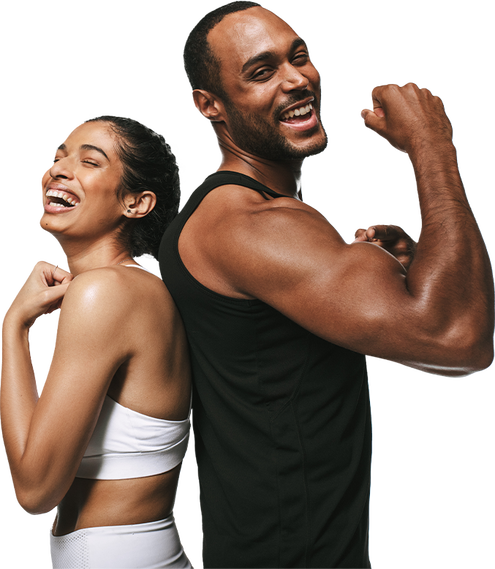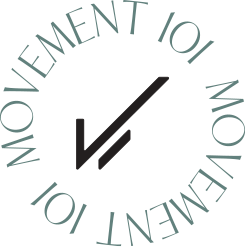|
How to use a hex bar.
I’m going to show you how to use a hex bar and explain why its such a good functional exercise. So, this is the bar weighting 20 kilos and I’ve got some plates in so it’s about 30. All we’re doing is squatting down, gripping the bar and lifting. You can stay here, put it back down or you can walk with it. And it’s a functional exercise because we do this movement all day, carrying shopping bags, carrying wheel barrels on the construction site, pushing prams. This works the grip strength, works your legs, works you arms and keeps your back straight and its super fun. Give it a go! Steps taken for this exercise:
No pain, no gain applies to working out. Expect to feel sore if you are working out for the first time, or pushing yourself to a new level. Before we get stronger with our bodies, it is normal to feel levels of discomfort and soreness. This leads to improvements in strength and endurance.
However, you want to pay attention to your body and make sure you aren't pushing yourself too far to injury. You wonder what the best ways to deal with sore muscles after working out are. You wonder if there's anything you are missing. You've googled some examples, and still, ask yourself "what are the best ways of dealing with sore muscles". No one wants to feel pain longer than necessary for the most part. Did you know that something as simple as stretching effectively may help reduce soreness after exercising? The best way to deal with sore muscles after working out is following these tips before and after your workouts. Just like you make time to workout, add in the time it takes for this preventative and restorative care. Your body will thank you. Anyone that's ever exercised knows the struggle of post-workout soreness. Check out this guide for the best ways of dealing with sore muscles. How to Deal With Sore Muscles After Working Out Sometimes we workout and we feel great before and after. Then, 2 to 3 days, or 48 to 72 hours later, we feel like we can't move because of the pain. This is when our bodies really go to work on repairing muscle fibers torn during exercise. It is important to realise that just because you are sore doesn't mean this equals growth or progress. When you overdo it, you may actually cause your muscle to atrophy because it can't effectively restore itself easily. You want to take care before, during, and after your workouts to effectively achieve the results you want without the unnecessary pain. This may include loosening tight muscles, practising foam rolling, and recovery time. Anyone that's ever exercised knows the struggle of post-workout soreness. Check out this guide on the best tips on working out tips and soreness after exercising. 1. Stretch Your Body Yes, it hurts. You feel like you want to crawl into bed and lay there for days. That's the worst thing you could do. The benefits of stretching include an increase in the blood flow to your muscles, as well as healing and preventing pain. The more adequately and consistently you do this, the more your body will thank you. Here are tips on stretching your quad muscles to get you started. 2. Take a Walk Even a light walk around the block will increase your blood flow and speed up the recovery process. Blood carries nutrients and oxygen to repair muscle tissue. The faster your blood flows, the faster you will feel better. 3. Foam Roll According to recent research, foam rolling your body like dough in baking may help reduce muscle soreness. The recommended time daily is 10 to 15 minutes before and/or after workouts. It helps relieve tension in your muscles' connective tissue. As a result, because of the increase in flexibility and tension release, it may improve performance in future workouts. That's what you wanted anyway, right? Here is a quick guide to help you get started with foam rolling. 4. Protein Intake The work you do on the inside is just as important. The average recommended protein intake daily is 1.4 to 2g per kilogram of bodyweight. Protein helps you build and maintain muscle so its actually just as important as your actual workout. Protein will help your muscles recover. That's why you hear trainers and nutritionists talk about your most important meal is what you eat before and after your workout. So for example, if you weigh 50kg, you would want to consume close to 100g of protein daily. Per meal, this will be about 20g if you are eating 5 times a day. This is the equivalent of a typical protein shake and/or 4 eggs to give you an idea. 5. Physiotherapy Care Sometimes when we go too far on a workout, you may feel an old back or neck injury flareup. You wait a couple of days, but it doesn't seem to go away with what you usually do after a workout. You may then want to look into physiotherapy as an ongoing preventative care solution to care for your body. 6. Massage Therapy Massages, or sports massages, may significantly reduce post-workout soreness especially when done immediately after a workout. If you wait 24-48 hours after your workout, your delayed onset muscle soreness may have already set it. As a result, your massage may be quite a bit more painful than if you went and did it right away. It's a great excuse for incorporating a regular massage into your self and preventative care routine. 7. Hydrate Hydrate We need water for energy. Think of a workout you had where you were not properly hydrated. Think of how you felt. When you compare this to a workout where you were properly hydrated and hydrated the entire time, it is night and day likely. The same goes for your sore muscles after working out. When we have less fluid in our body, our body has to work harder to pump blood. This then leads to longer recovery time for your body. Water also flushes impurities and toxins out of our bodies. The bottom line - make sure you hydrate before, during, and after your workouts. The average person should consume half of their body weight at a minimum daily. If you are working out strenuously, this typically means more water is required. Many athletes easily consume a gallon of water daily. Sore Muscles After Working Out In summary, focus on fueling and movement for your body before, during, and after workouts. For the food and water we consume to the movement before and after our workouts, it all impacts how fast our recovery. A word of advice implement these recommendations before the next time your body is so sore after a workout that you can't move. To learn more about physiotherapy, massage, pilates, and exercise physiology, visit us here for information.
Hey guys, its Daniel from Movement 101, a common question that I get asked is what the best way is to lift something. So, I’m going to show you a few variations. With a dumbbell such as this you can squat, you can dead lift or hip hinge, you can stoop down using your spine bending or you can lunge like this. For a barbell if you want to stoop down or bend that’s okay, especially if you are accustomed to it and your strong in that position, you can also hip hinge or dead lift. If you want to squat, see how much further the weight is and notice if you practice a squat and a lunge with the weight in front of you, it makes it a lot hard. This is just to illustrate that there’s no one best way, it depends on the task and the object and what you are accustomed to. The best way is to train with a variety of options, get strong in all ranges of motion. Get confident in all ranges of motion and this will improve your capacity, reducing your risk of injury.
Hey guys, it’s Daniel from movement 101 and today I’m going to give you a quick tip for step ups. One of the variations is for cardio, so going up and down using your arms and keeping your heart rate high. Another variation is to load the front leg a bit more. A common mistake made is usually when you want to load up the front leg a bit more or even when the step is too high, this causes you to use the back leg/calf to push yourself up. One way around that is to keep the toe on the back leg pointed upwards to the ceiling and maintaining the toes up whilst leaning forwards. Another way to avoid this is to use a weight plate underneath your heels. This stops you from pushing your toes down on the ground, by elevating your toes off the ground. This again load the front leg a lot more and pushing and using momentum. So I hope that helps.
|
AuthorWrite something about yourself. No need to be fancy, just an overview. Archives
April 2024
Categories |
|
|
|


 RSS Feed
RSS Feed









